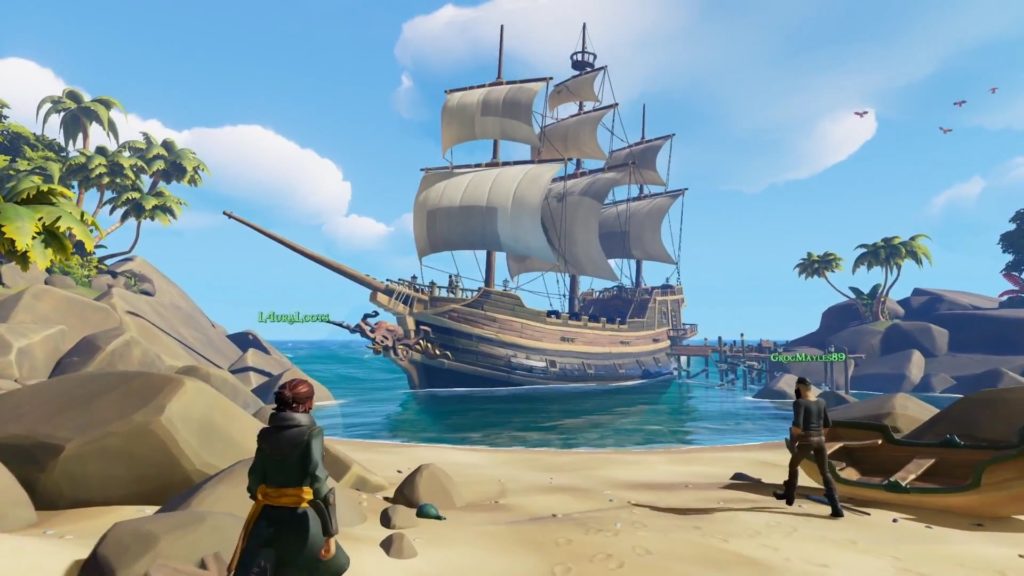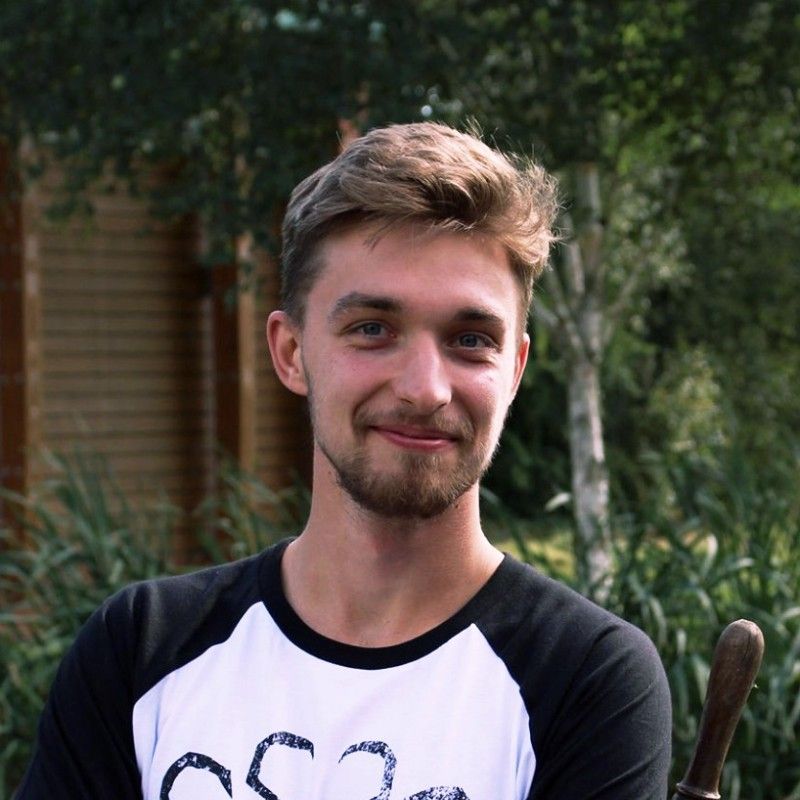In July 2018 Jiri Baran joined Rare as a Community Management Intern.
He has been working there as a community developer for almost a year now.
How was the move to England?
I had a slightly different movement with it than most. I went to the UK to study at the university. The move was easy, I just packed three big boxes (30kg each) and sent them to DPD. Parcels arrived the next day after arrival, nothing was lost. Moving is always annoying, but it depends on the approach. Through Couchsurfing in Amsterdam, I met a Slovak who traveled a lot and moved frequently. Even though he was not a minimalist, he was smart. When it came time to raise the anchors, he simply sold everything he had and took only what he could fit in his backpack with him to his new location. At the new place, he again bought what he needed, kept things in good condition, and how many times he allegedly sold for more than he originally bought at the entrance.
How did you get into the game studio?
Finding a job in the UK after school was sort of part of the dream plan, but it didn’t even cross my mind at the time that it would be in the gaming industry. Working in games has been my dream since childhood. I’ve always enjoyed inventing stories and game mechanics. I’ve been telling this to my parents at home since first grade. However, over time, I abandoned the gaming dream. After all, I didn’t know how to program and didn’t excel at computer graphics. And so (very naively) I thought I had no place in the gaming industry. However, I did not want to give up the design spirit and imagination. As a scout leader, I focused on developing camp programs, year-round games, or little puns for get-togethers. Those were the best years and I wouldn’t trade them for full knowledge of C++!
In England, I settled on the city of Plymouth. It has a good university and, above all, it is located on the beautiful south coast. I went to study marketing, which was and still is absolutely perfect for me. It combines psychology and sociology with economics, and is also heavily devoted to creativity. At that time, the gaming industry was just a dream, and I might someday get lucky professionally. If only I had known then that finding an internship would change everything. The internship was also one of the reasons why I initially went to study abroad. We don’t have a proper internship system in the Czech Republic, and until education and companies start to move a bit, college students will be more likely to be behind the supermarket checkout than where they can really make a positive impact.
It was December at that time, I returned home to the Czech Republic and instead of looking for an internship, I spent time playing Sea of Thieves, where I had just been selected for closed beta testing. I was delighted with the project, watched the game from the first trailer. One evening I came up with a saving idea, with which, in fact, my career began – is the studio developed by Sea of Thieves looking for interns? Well, it turns out he’s looking. They even had an open position for a community manager, for which I was more than well prepared by two years of market research and other previous experience. I first joined Rare as a community management intern.
What exactly are you doing as a Community Manager at Sea of Thieves? Are you working on another game of theirs?
I started working as a community management intern about a month after Sea of Thieves came out. For the first few weeks I was engaged in the so-called “surveillance”. I always shadowed someone on the team for a few days to understand what he is responsible for, how and why he does what he does, etc. There were six of us on the team then, I think six. Sea of Thieves Community Managers have separate channels and platforms – Twitter, Discord and Xbox Club, SoT Forum and “Insider”, that is, our cohort of passionate players and volunteers with access to the test server, etc. Then the department in led by the Head of the Community and, of course, perhaps the busiest person in the studio – our editor. Apparently, I was in charge of Facebook and Instagram. My main role was to engage the players and fans in conversation, inform about news and development of the game, and constantly gather feedback and sentiment, which we then passed on to the rest of the studio.
In parallel with the community team, we have an even smaller team that focuses on content creators – streamers, youtubers, and Sea of Thieves partners.

Being an intern was great, I could stick my nose where I could and learn a lot about running a game studio and the industry in general. After 12 months of internship, I had a few months left before my semester started, so I was happy to accept the position of Community Developer Assistant to fill that time. I was supposed to start a project that I developed in part as an intern focused on the international community and the Discord servers that were built around SoT that year.
Otherwise, to the job of the community manager – as I said, at Rare, the community team is primarily responsible for individual media and communication with fans.
There is always something going on in the world of Sea of Thieves and the community team plays a key role in keeping all of our players and the community informed. They have a free hand in this regard, but it must fit into the overall strategy and marketing plan. Two years ago, when we released SoT, the main goal was to expand the content of the sandbox and enrich the gameplay. The release of Sea of Thieves didn’t go smoothly and we had to pivot to change the stigma of the beautiful but very shallow ocean that Sea of Thieves has stuck to since launch. It took a year, costing a lot of nerves, sweat and tears, and most importantly, countless patches, a bunch of small updates and about six major content updates before we succeeded. It’s worth adding that SoT as a game-as-a-service model has all these updates for free, players just need to buy the game itself or play through Xbox Game Pass. Hats off to all programmers, graphic designers, animators, designers, service workers and everyone involved. At that time, my contribution as an intern was very tiny compared to others, but being right in the middle of the action was an invaluable experience that I am very happy about today.
You must have covered several techniques during this time. What do you think is the most common mistake of a community manager / assistant developer, and what, on the contrary, is a good practice that you came up with during your work?
As for the most common mistakes, I certainly cannot preach any great wisdom. From my humble experience, I can say one thing. The right community manager should serve as a “funnel” for the rest of the team. He should be the lawyer and voice of the player community at the developer table. Especially for those team members who do not have the time or energy to read hundreds of comments on social networks and forums. However, it is necessary to be able to distinguish between the opinion of a handful of high-profile avid superfans and the rest of the community of players who play the game more casually. It’s a bit like walking a tightrope. If the community manager leans too much one way or the other, he will fall and may take the rest of the development with him. Filtering and properly balancing player feedback is difficult, I don’t think there is any perfect method or answer. We always try to get closer to the ideal result.
Personally, I see superfans’ opinions as great food for thought. The answer to the question is whether it makes sense to follow them deeper, however I look in the data. For example, I often see on the forums, or hear from streamers, that more clothes and other cosmetic items should be added to the game so that they have something to spend on the saved millions of in-game money. But these players have recorded hundreds if not thousands of hours and own just about everything you can buy. When I look at the data, I find that the average gamer has only amassed a few tens of thousands and only owns a select handful of cosmetics—the ones that appeal to them the most. From this, we can conclude that this problem is actually not as big as some players like to portray it, and that there may be a better solution that will enrich both hardcore veterans and more casual players. Working closely with the Business Intelligence team and Player Insights is above gold, make friends in this department.
Such a classic of community management: the Internet is full of haters, it is important to maintain composure and distance. A bunch of negative comments, insults or threats can easily offend a negligent CM. You need to be able to balance this with positive comments, and in extreme cases with a sufficient dose of videos about kittens.
“The internet is full of haters, it’s important to keep your cool and your distance.”
After all, a snippet for all developers who dare to venture into the relentless social media market. No need to participate in every social media conversation that concerns it. Although our team and studio as such encourage employees and developers to feel free to participate in online conversations and not be afraid to share their passion. However, when it comes to attacks and negativity of all kinds, keeping and ignoring them is often the best strategy.
What exactly are you doing now?
My current position as Community Developer today is for a brand new team called “Live Service” that was formed in 2020 and is separate from the Engagement team. We are focused on the overall operation of Sea of Thieves as a service, and our goal is to give players a good reason to come back to us every month. Much of it is an effort to add new content and features in relation to the overall product strategy and especially our community. As a community developer on a pirate game, I mainly care about AARRR. This is not a joke, but an abbreviation for “acquisition”, “activation”, “hold”, “recommendation” and “income”. In terms of overall marketing strategy, I design, develop, and deliver projects that target some of the AARRR metrics or other community-related opportunities or challenges. I often focus on a certain part of the players, for example, those who play only occasionally or for a while, and then leave.
For most of the past year, I’ve been working on the Seasons project to keep new players. However, we do not use any unethical marketing practices such as certain mobile or PC games. To convince players to give Sea of Thieves another try, or to turn less enthusiastic players into avid members of the community, we only have to figure out what they’re not comfortable with and stop them from having a satisfying experience. Or, on the contrary, find out what exactly they like and what they want more. Then, using qualitative research and real data, we identified a number of improvements that we can make to the game. Over time, a common core of the gameplay itself emerged, especially the progression and reward system. Sea of Thieves: Season One came out at the end of January this year and has delivered a number of satisfying results.
Source :Indian TV

